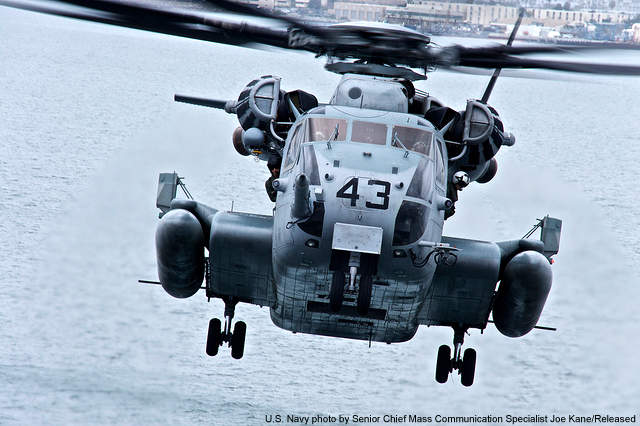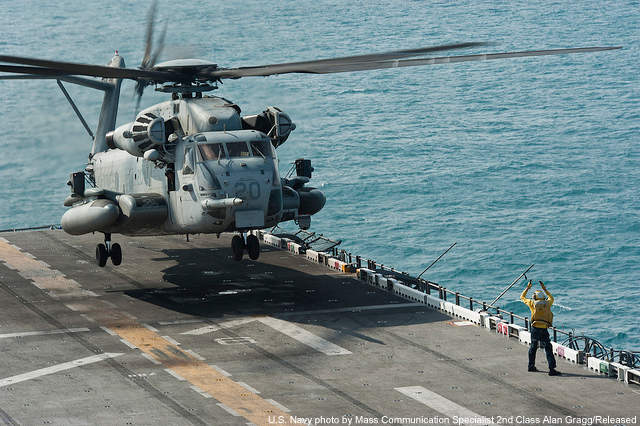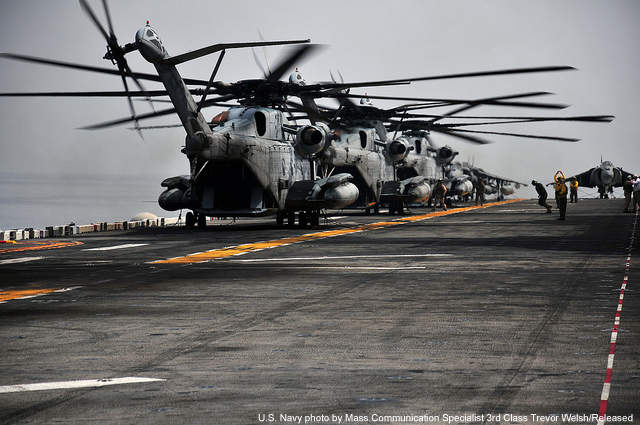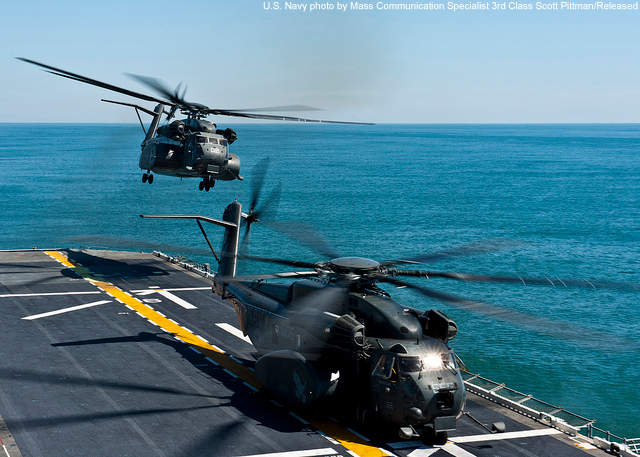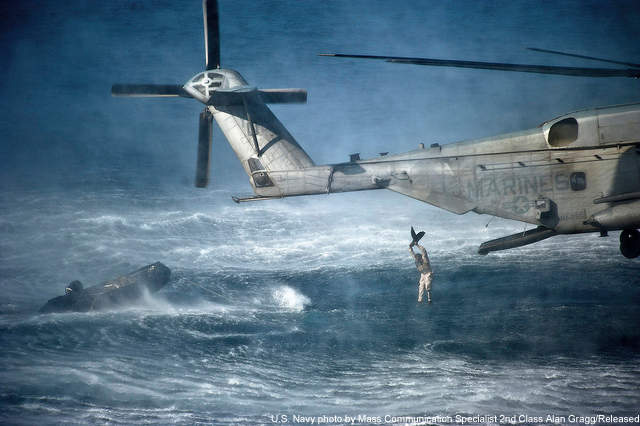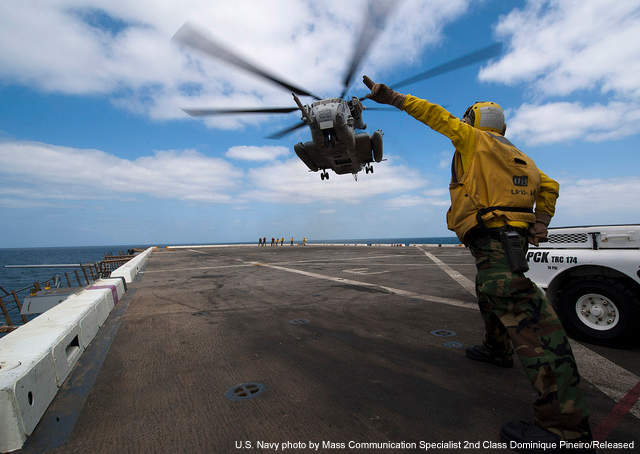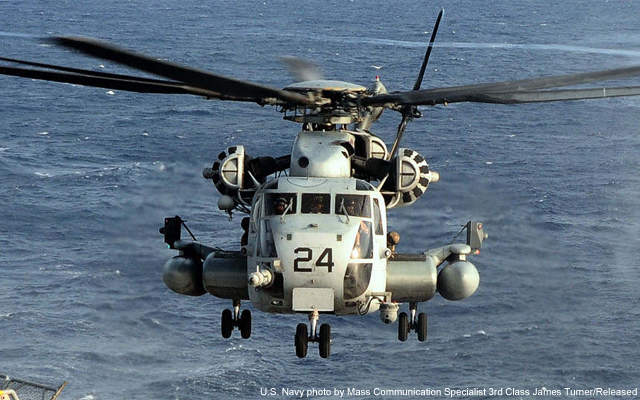The Sikorsky CH-53 Super Stallion heavy-lift helicopter first flew in 1974 and entered service with the US Marine Corps (USMC) in 1981. A total of 172 Super Stallions have been delivered and 165 are in service with marine corps squadrons in the Pacific Fleet and in the Atlantic Fleet.
The helicopter is also in service with the marine corps reserve, training and experimental squadrons. The final Super Stallion for the USMC was delivered in November 2003.
US Marine Corps amphibious assault helicopter
The marine corp uses the Super Stallion in the amphibious assault role and for transporting heavy equipment. The US Navy also use the Super Stallion for vertical delivery and recovery of damaged aircraft on aircraft carriers.
In 2000, the USMC announced the CH-53X programme to upgrade the CH-53E and extend its service life to 2025. Upgrades would include a new engine, substantially increased payload capacity, all-composite rotor, elastomeric rotor head and glass cockpit with fly-by-wire controls.
In March 2004, a USMC analysis of alternatives (AoA) determined that a new-build airframe would be a more cost-effective solution. Sikorsky was awarded an initial system development and demonstration (SDD) contract for the new helicopter, which is designated the CH-53K heavy-lift rotorcraft (HLR), in January 2006 and the full SDD contract in April 2006.
The GE38-1B engine was selected to power the CH-53K in December 2006. Requirement is for 156 helicopters and service entry is planned for 2015.
CH-53E Super Stallion seven-bladed rotor design
The fuselage is watertight and of light alloy, steel and titanium construction. The cockpit includes glass fibre and epoxy materials.
The seven-bladed main rotor is fitted with a Sikorsky blade inspection system. The main rotor blades are of Nomex honeycomb construction with a titanium spar and a composite glass fibre and epoxy skin. The rotor head is primarily titanium and steel.
Super Stallion cockpit
The CH-53E accommodates three crew. The helicopter is equipped with a Hamilton Sundstrand automatic flight control system (AFCS), with two digital flight control computers, a four-axis auto-pilot, an attitude and heading reference system (AHRS), a Rockwell Collins GPS 3A global positioning system and a Northrop Grumman (Teledyne Ryan) AN/APN-217 Doppler radar. The AHRS has been replaced with a new system from BAE Systems.
The cockpit displays include four 152mm × 152mm (6in²) colour displays, type CM A-2082, supplied by CMC Electronics (formerly Canadian Marconi) and an Elbit ANVIS 7 NVG/HUD head-up display.
The cockpit is night vision goggle compatible for AN/AVS-6 NVGs. The helicopter night vision system (HNVS) allows low-altitude operations at night and in adverse weather.
The HNVS includes a pilot night vision system (PNVS) by Lockheed Martin, a Honeywell integrated helmet and display sighting system (IHADSS) and a Raytheon Systems (formerly Hughes) forward looking infrared, AN/AAQ-16B FLIR.
In September 2005, Raytheon was awarded a contract to provide a new AN/AAQ-29A FLIR for the CH-53E. The AAQ-29A is a three-field-of-view FLIR with a 3-5 micron, indium antinomide 480 × 640 element array.
The cockpit is fitted with a Rockwell Collins AN/ARC-210 secure tactical radio communications system. The helicopter can be equipped with a Goodrich health and usage monitoring system (HUMS).
Multiconfiguration cabin onboard the Sikorsky CH-53 heavy-lift helicopter
The cabin is fitted with folding canvas seats along the sides in normal configuration to seat 37 but the addition of a centre row allows the accommodation of a total of 55 troops. Martin Baker, with headquarters in Uxbridge in UK, has been awarded a $20m contract to supply new crashworthy seats, 31 to a helicopter.
The cabin is equipped with a hydraulically operated rear ramp for loading freight. The cabin can hold up to seven standard 1.02m × 1.22m (40in × 48in) pallets and the helicopter can carry a maximum internal load of 14,515kg.
An external load lift system developed by Skyhook Technologies allows the helicopter to carry separate underslung loads that can be carried simultaneously and delivered separately to different drop locations. The Super Stallion can carry a maximum external payload of 16,330kg.
Electronic warfare capabilities
The Super Stallion is equipped with an ATK AN/AAR-47 missile warning system and chaff and flare dispensers.
An initial six CH-53 helicopters of the German Armed Forces are fitted with the EADS AN/AAR-60 MILDS missile warning system, also fitted on the NH90 and Tiger helicopters.
In June 2007, Northrop Grumman was awarded a contract to equip the USMC CH-53E helicopters with the directional infrared countermeasures system (DIRCM).
In January 2011, Rockwell Collins was awarded a $7.6m contract to provide electronic radio and ancillary equipment in support of the CH-53E programme. The equipment supply contract is expected to be completed by July 2012.
CH-53E turbofan engines
The CH-53E helicopters are powered by three General Electric turbofan engines, type T64-GE-416 rated at 3,266kW. The engine cowlings and transmission fairings are of Kevlar construction.
Self-sealing bladder fuel tanks, each of 1,192l capacity, are installed in the forward sections. An internal two-cell fuel tank provides 1,465l of fuel. Drop tanks, with total capacity 4,921l, can also be installed externally. For extended range operations the helicopter can be fitted with seven additional tanks providing an additional 7,949l of fuel.
The Super Stallion can extend its range and endurance through in-flight refuelling. The helicopter is fitted with a forward extendable in-flight refuelling probe and it can also hoist hose refuel from a surface ship whilst in hover mode.
Sikorsky CH-53 Super Stallion heavy-lift helicopter weapons
The only original armament on a CH-53E were two 0.50-calibre machine guns mounted in the windows on the sides of the helicopter. These could only cover the front and most of the sides, leaving the rear exposed.
A total of 172 Super Stallions have been delivered and 165 are in service with marine corps squadrons in the Pacific Fleet
A ramp-mounted weapon system (RMWS) has been developed and evaluated by the US Marine Corps. The M3M RMWS is a Fabrique Nationale Herstal GAU-21 0.50-calibre reduced-recoil machine gun soft-mounted on the ramp, which can be removed and installed in less than two minutes.
The M3M has a rate of fire of 1,100 rounds a minute. By January 2011, the US Navy helicopters were fitted with three GAU-21 or XM-218 .50 cal. machine guns.
The retractable tricycle-type landing gear consists of three twin-wheeled units. The main units retract into the rear of the sponsons.
MH-53E Sea Dragon AMCM variant
The MH-53E Sea Dragon variant is primarily dedicated to Airborne Mine Countermeasures (AMCM) operations and has been in service with the US Navy since 1986. More than 40 were delivered.
The MH-53E is heavier than the CH-53E with enlarged fuel sponsons for greater fuel capacity. It is being upgraded with more powerful 3,729kW T64-GE-419 engines.
It is equipped with the Edo AN/ALQ-166 minesweeping sled, the Northrop Grumman AN/AQS-14 side-scan sonar and the AN/ALQ-141 minesweeping system. It is being fitted with the Lockheed Martin AN/AQS-232 airborne mine neutralisation system (AMNS).
An export version, the S-80, is in service with the Japanese Defence Agency.

